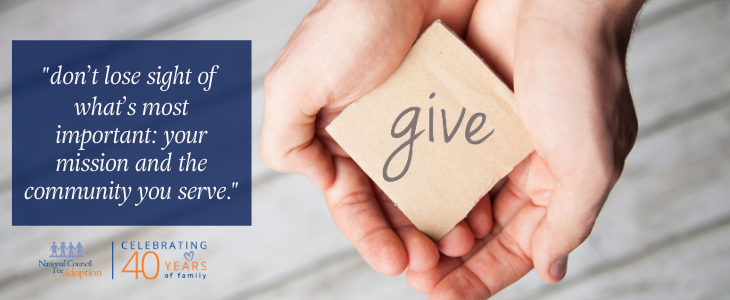Best Practices for Donor Communication in a Crisis

In today's blog post, NCFA's Development Team offers our member agencies, primarily nonprofit organizations, best practices and tips for effectively communicating with donors and fundraising in a difficult economic environment.
By now, you’ve heard a steady drumbeat of dire warnings that the months ahead will be difficult for all nonprofits – and they will certainly be a challenge. There are reasons for optimism, however – many charitable organizations and community-minded individuals, eager to find productive ways to help, are stepping up wherever they can. Meanwhile, recessions in decades past have offered valuable lessons and best practices for how those in donor-supported organizations can maintain and even grow their operations.
• Do show how you are part of the solution. Human service charities that help the most vulnerable have a critical role to play right now – and that certainly includes adoption service providers. Share with your donors what you are doing to support families through this crisis.
• Don’t fundraise from a place of panic. Savvy donors are rarely interested in giving to a nonprofit that sounds like it’s on its last legs. You can be transparent about your financial position, especially with your best and most loyal supporters, but by all means resist the temptation to frame an appeal as though it’s the only thing keeping the doors open and lights on.
• Do remain in contact with supporters. Nonprofits that came out of the 2008-09 recession in the strongest positions were those that communicated clearly and regularly with donors and stakeholders. This isn’t the time to retreat from your communications plan – acknowledge the current situation and its impact, but make clear that your important work carries on!
• Don’t be afraid to be personal. It’s likely that you’ve developed some close relationships over the years with your key supporters; many, if not all, of your donors are giving because they feel a strong emotional connection with your work. Make time to check in directly with supporters you know well, simply to ask about their health and safety. Let the human element enter all your donor communications. Show that you care.
Remember, building and maintaining donor relationships is part of a long-term plan. Your best and most loyal supporters are the ones who will help see your organization through uncertain times like these, so don’t panic. Stay focused on open and regular communication with all of your supporters, and most importantly, don’t lose sight of what’s most important: your mission and the community you serve.



